Hemiramphidae is a family of fishes that are commonly called halfbeaks, spipe fish or spipefish. They are a geographically widespread and numerically abundant family of epipelagic fish inhabiting warm waters around the world. The halfbeaks are named for their distinctive jaws, in which the lower jaws are significantly longer than the upper jaws. The similar viviparous halfbeaks have often been included in this family.
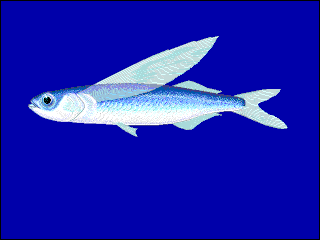
Beloniformes is an order composed of six families of freshwater and marine ray-finned fish:

Bulimba Creek, originally known as Doboy Creek or Doughboy Creek, is a perennial stream that is a tributary of the Brisbane River, located in suburban Brisbane in the South East region of Queensland, Australia.
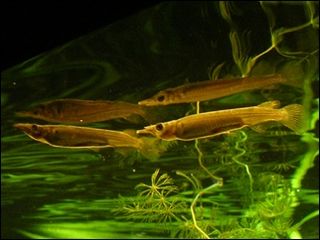
The wrestling halfbeak also known as Malayan halfbeak is a species of viviparous halfbeak native to the fresh and brackish waters of rivers and coastal regions in South-East Asia, in Singapore, Thailand, Indonesia, Thailand, Malaysia, Borneo and Sumatra. It is a small, slender, livebearing fish, with the elongated lower jaw characteristic of its family. The colour of this species varies, depending on where the specimen is found. It is the type species of the genus Dermogenys.
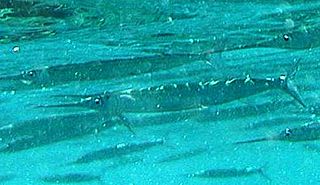
Hemiramphus is a genus of schooling marine fish commonly called halfbeaks, garfish, or ballyhoos, and are members of the family Hemiramphidae. They inhabit the surface of warm temperate and tropical sea, and feed on algae, plankton, and smaller fish. Hemiramphus species are edible but are more important as food fish for larger predatory species including dolphinfish and billfish.
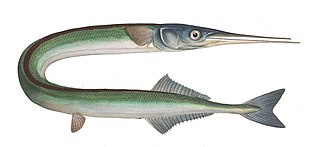
The garfish, also known as the garpike or sea needle, is a pelagic, oceanodromous needlefish found in brackish and marine waters of the Atlantic Ocean and the Mediterranean, Caribbean, Black, and Baltic Seas.

Hyporhamphus ihi, the known as the garfish, piper or by its Māori name takeke, is a halfbeak found all around New Zealand in shallow inshore waters.

The Dussumier's halfbeak, also known as the slender garfish, lives in reefs and shallow lagoons. It is an Indo-Pacific species which is found from the Seychelles east to the Tuamotu Islands, north to Hong Kong and Okinawa and south to northern Australia. They form schools which are found near the surface of lagoons and seaward reefs. The longest known specimen was 38.0 cm in length. This species was described by Achille Valenciennes in 1847 with the type locality given as the Seychelles. The specific name honours the French voyager and merchant Jean-Jacques Dussumier (1792-1883).

Arrhamphus is a small genus of halfbeaks from the family Hemiramphidae from the coasts of Australia, the two species in the genus were formerly considered to be conspecific.

Zenarchopterus is a genus of viviparous halfbeaks. These fish are found in marine, brackish and fresh water of the Indo-Pacific region. Despite being in the viviparous halfbeak family, Zenarchopterus species are oviparous.
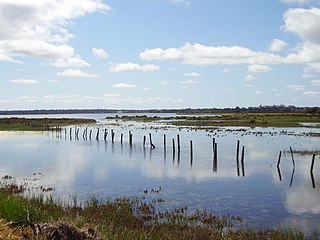
The Vasse-Wonnerup Estuary is an estuary in the South West region of Western Australia close to the town of Busselton. The estuary is listed with DIWA. It was also recognised as a wetland of international importance under the Ramsar Convention on 7 June 1990 when an area of 1,115 ha was designated Ramsar Site 484 as an important dry-season habitat for waterbirds. It is also the main part of the 2,038 ha (5,040-acre) Busselton Wetlands Important Bird Area.

Hyporhamphus is a genus of halfbeaks. The species in this genus are distributed throughout the warmer seas of the world, most species being Indo-Pacific and there are some freshwater species.
The short-beaked garfish is an uncommon species of needlefish in marine waters of the eastern Atlantic Ocean. This pelagic needlefish is present off the coasts of Ireland, Spain, Portugal, and the United Kingdom, and possibly in the Mediterranean Sea, as well. This species was thought to be the same as the garfish because they share the same waters. The short-beaked garfish matures at 30 cm (12 in) and can grow to a maximum of 65 cm (26 in) while Belone belone can be 95 cm (38 in). Like all needlefish, this one has an elongated body with beak-like jaws that are lined with razor sharp teeth. The short-beaked garfish's lower jaw is longer than the upper. Its body is silvery like most needlefish and has a black stripe running across its lateral line. The dorsal and anal fins are very close to the caudal peduncle. These fish are oviparous. Eggs may be found attached to objects in the water by tendrils on the egg's surface. These spherical eggs are dispersed on the sea floor (demersal). Not much is known about this fish's feeding habits. It likely preys on small oceangoing fish. It has been caught using mackerel. Needlefish tend to be surface fish, so are preyed upon like Atlantic mackerel, European pilchard, sand smelt, etc. The specific name honours Anatolii Nikolaevich Svetovidov (1903-1985) who was an ichthyologist at the Zoological Institute in Saint Petersburg, Russia and a colleague of N.V. Parin.
The black-tipped halfbeak, Hyporhamphus neglectissimus, is a halfbeak from the family Hemiramphidae.
The feathered river garfish, also known as the estuarine halfbeak, spoon-fin garfish, spoon-fin river garfish and viviparous half beak, is a species of marine, freshwater, brackish and reef-associated oceanodromous viviparous halfbeak found in Indo-Pacific regional countries, such as Kenya, Mozambique, Seychelles, Madagascar, New Guinea, Solomon Islands, Australia, New Caledonia, Fiji, Sri Lanka, India, Vanuatu, Malaysia, Thailand, Singapore and Samoa.

Hemiramphus far, the halfbeak, black-barred halfbeak, black-barred garfish, barred halfbeak, barred garfish or spotted halfbeak, is a schooling marine fish belonging to the family Hemiramphidae, the halfbeaks. It has an Indo-Pacific distribution and has invaded the eastern Mediterranean through the Suez Canal.
Hyporhamphus affinis, the tropical halfbeak, tropical garfish, insular halfbeak or coral reef halfbeak, is a species of schooling marine fish from the family Hemiramphidae. It is distributed through the Indo-Pacific regions and has been recorded in the Mediterranean Sea which it reached through the Suez Canal.
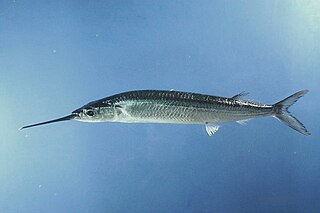
Hyporhamphus unifasciatus, the common halfbeak or the Atlantic silverstripe halfbeak, is a bony fish in the family Hemiramphidae. It is found in the subtropical western Atlantic Ocean and the Gulf of Mexico. It is a common fish and not used for food to any great extent, and the International Union for Conservation of Nature has listed its conservation status as being of "least concern".
Arrhamphus krefftii, the snub-nosed garfish, is a species of halfbeak in the genus Arrhamphus found in coastal waters of Australia from south of Rockhampton in Queensland to Sydney. The identity of the person honoured in the specific name is uncertain but it is thought that it may be the Australian zoologist and paleontologist Gerard Krefft (1830–1881). This species was previously classified as a subspecies of Arrhamphus sclerolepis, and remains so according to some authorities. This species is a herbivore and eats seagrass during the day. At night, it is a carnivore, eating mainly crustaceans.
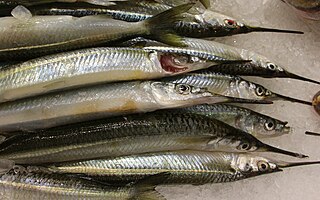
Hyporhamphus regularis is a halfbeak garfish from the family Hemiramphidae. It is found in Australian waters. The red tip on the lower jaw is an identification feature.














